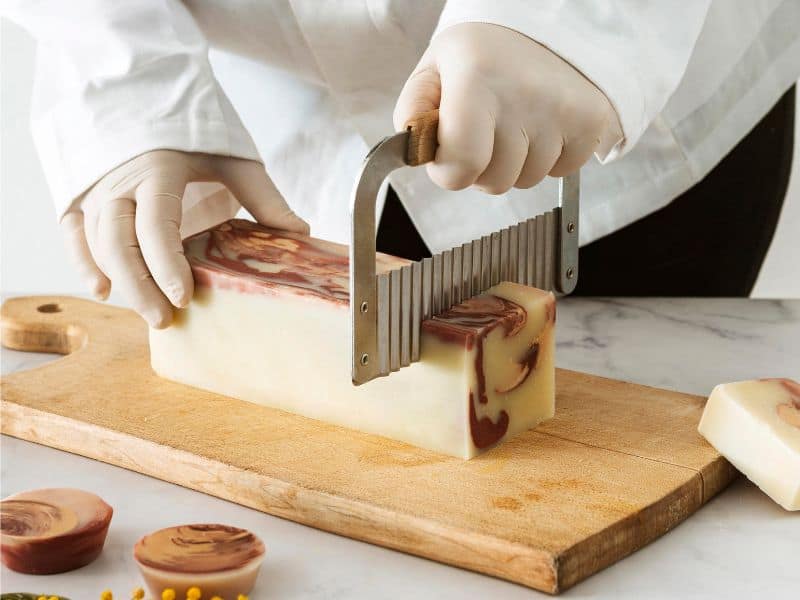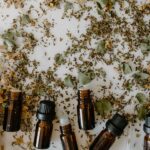Making your own soap can be a fun and rewarding experience. But sometimes, when you’re creating cold process soap, something goes wrong and it starts to leak oil. It’s not only annoying but it can make your soap look horrible. The good news is the problem can be fixed.
Cold process soaps can leak oil due to overheating, unblended oils, or false trace. Fortunately, the problem is usually easy to fix by melting and mixing the soap again and repouring it into a cool mold – allowing it to set at room temperature until firm enough to cut.
If you are new to soap making the issue could have been with some of your measurements for fragrance oil or superfat. However, if you are certain that you had the correct amounts of the right ingredients then it could be a clash between ingredients or the mixture simply getting too hot.
Determining Why CP Soap Is Leaking Oil
As mentioned above, this could be caused by a few different issues. Let’s look at each one.
Overheating
This happens when the soap mixture has been heated too much. As it begins to cool, the mix can expand and contract, which can cause oil to seep out. To fix it, simply reheat and mix the soap with a stick blender or immersion blender until smooth. Then repour it into the soap molds.
Fragrance Oil & Superfat
If you had the wrong measurement for your fragrance oil or superfat, this can cause a problem. Too much of either ingredient can make the mixture harder to work with and, as a result, it won’t bind together properly. This can cause oil to leak out. If this is the case, create more soap base with reduced oil and sodium hydroxide and then mix it with the batch you already have.
Once you have made sure that both batches are combined thoroughly you will be able to repour them into your molds and wait for them to begin to set up.
False Trace
False trace is a big problem when it comes to soap making. Trace in soap making is the point when the oils and the lye appear to have saponified but have not yet actually completed saponification. You can identify false trace in soap making by letting the mixture sit for a moment and then looking for an oily sheen on the surface of the mixture or any runny oily areas.
If you spot any oil then make sure to keep mixing thoroughly until trace appears to have started.
Undermixed
If your soap isn’t mixed well enough it can cause oil to leak out. This means that the fats and oils have not completely blended with the lye solution – leaving unblended oils in your mixture which can seep out over time. You can prevent this by mixing thoroughly with a stick blender or immersion blender until trace.
Clash of Ingredients
Occasionally you will get a clash of ingredients. Two ingredients that just to not want to go together. When you experience this you can try changing the proportions of your recipe or just taking out one of the ingredients altogether.
Preventing CP Soap From Leaking Oil
The best way to prevent your cold process soap from leaking oil is to follow the right recipe and measurements, mix thoroughly and make sure that you do not overheat your mixture. If you take all these steps then you should be able to create perfect batches of cold-process soap every time!
If something does go wrong, however, don’t worry as it is usually easy to fix. Simply reheat and mix the soap, and repour it into a cool mold, allowing it to set at room temperature until firm enough to cut.
Cold Process Soap-Making Tips
When you are making cold-process soap, here are a few tips to keep in mind:
- Use quality ingredients – the better the ingredients, the better the soap will turn out.
- Accurately measure your ingredients and follow your recipe exactly.
- Use a stick blender or immersion blender to mix until trace appears.
- Do not overheat your mixture as this can cause oil to leak out as it cools.
- Allow the soap to set up at room temperature before cutting it into bars.
When you are starting out as a new soap maker it is important to not get too crazy until you understand every part of the soap-making process thoroughly it is important to not stray too far from the recipe or soap-making instructions that you are using.
Once you are a bit more experienced and understand all of the possible risks then you can get creative and make your own custom soap recipes.
By following these simple steps and tips, you should be able to make high-quality cold-process soaps without any problems!
Frequently Asked Questions
The most common cause of this is from either overexposure to heat, unblended oils or false trace. The best way to prevent your cold process soap from leaking oil is to follow the right recipe and measurements, mix thoroughly and make sure that you do not overheat your mixture.
Cold process soap can last for up to 5 years if stored in a cool, dry place. However, if the soap is exposed to high humidity or dampness it can start to develop mold. To prolong the life of your soap, store it in an airtight container and keep it away from areas that are prone to moisture.
Yes, it can. Cold process soap is ready to use as soon as it has cured and hardened. To ensure that the soap is fully cured, allow it to sit for at least 4-6 weeks before using it. This will help give the soap a longer shelf life and ensure optimum performance.
Cold process soap should be stored in an airtight container away from areas that are prone to moisture. This will help prolong the life of your soap and keep it from developing mold or bacteria. You can also wrap the soap in plastic wrap or parchment paper to further protect it from moisture.
False trace is when the mixture appears to have reached trace, but has not actually achieved it. This can occur if the oils and lye solution have not been mixed thoroughly. False trace can be identified by the soap having a thin, watery consistency and not holding its shape.
Conclusion
In conclusion, cold-process soap making can be a tricky yet rewarding craft. However, if you follow the right steps and use quality ingredients, you should have no trouble creating perfect batches of cold-process soap every time! If something does go wrong, don’t worry as it is usually easy to fix by reheating and mixing the soap, and repouring it into a cool mold.
Finally, make sure to properly store your soap away from areas prone to moisture in order to extend its life and keep it from developing mold. Good luck and enjoy your new hobby!






